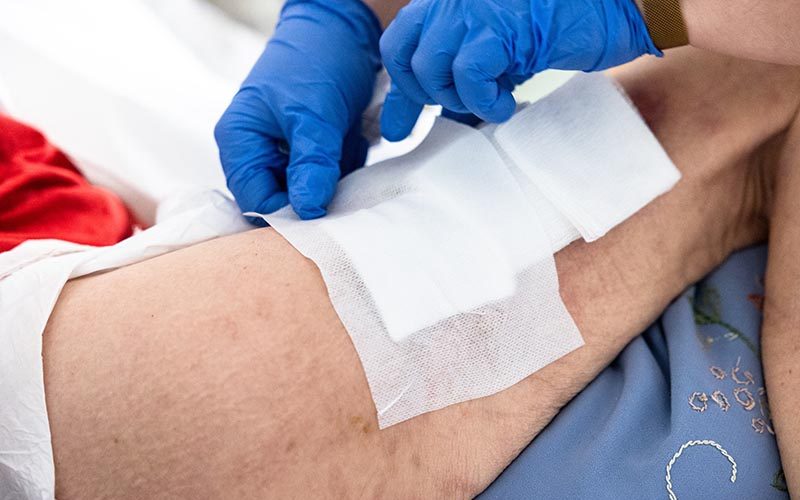Fungal infections are common in nursing homes. They are caused by fungi that thrive in warm, moist environments. Infections caused by fungi, such as yeast and Candida, commonly cause respiratory problems during long-term care. They can also affect patients’ skin, nails, and mouth.
Fungal infection in nursing homes can be fatal if they become bloodstream infections or get into other organs and cause pneumonia, meningitis or sepsis.
These infections are more common in nursing homes than in other types of institutions because of the weakened immune systems of the elderly, as well as because the environment is often less controlled than in hospitals.
Infected patients may have no symptoms at first, but over time, the fungus can spread through their bodies and cause serious medical problems if left untreated.
However, new reports have found that nursing homes are breeding grounds for Candida Auris, considered the most common infection in nursing homes today.
US health officials report that a few hospitals and nursing homes in the United States have been infected with an untreatable fungus, an Associated Press publication reports.
According to the Center for Disease Control and Prevention (CDC), two Dallas area hospitals and a nursing home had outbreaks of the “superbug” infections. The report added that there were few patients with invasive fungal infections resistant to all three major classes of medications.
Candida Auris Explained
The CDC defines the Candida Auris fungus as a new species of fungal infection that affects older adults, particularly very sick patients and is resistant to many drugs used to treat other fungi.
This recently discovered drug-resistant fungal infection can cause serious health problems, including pneumonia, meningitis, and other medical conditions. Infections occur when people breathe in fungal spores that are present in the air. The spores can come from infected nursing home patients or contaminated surfaces.
This deadly fungus is often found in hospitals and long term care facilities, but it’s also on the rise in other parts of the population as well, public health officials in national institutes have warned.
While there have been numerous reported cases of Candida Auris infections in New York and Chicago, these infections can occur anywhere. A proactive approach to infection control is especially recommended for Texas patients and healthcare facilities to prevent the spread of this fungus.
According to researchers at Johns Hopkins Bloomberg School of Public Health, Auris may be one of the first examples of pathogenic fungi arising from climate change, and its emanation raises concerns that fungi may adapt to warmer climates and cause new diseases.
What is the origin of Candida Auris?
Candida Auris was first discovered in 2009 by doctors in Japan who were treating a woman with an ear infection. The infection was later identified as a different species from C. Albicans, which causes thrush and yeast infections in humans, and the origin of the first known strain traced to 1996 in South Korea. This new fungus species is drug-resistant to common antifungal prescriptions such as fluconazole, itraconazole, or ketoconazole.
“Candida” is typically associated with yeast infections, but Candida Auris is different. This fatal fungus in nursing homes is contagious and fully resistant to many antifungals, including commonly used treatments. It often preys on critically ill nursing home patients, especially in long term care facilities with poor care and inadequate staffing.
To prevent Candida Auris, it is vital to know about this deadly fungal infection if you or a family member lives in a nursing home.
What are Candida Auris signs and symptoms?
Candida Auris symptoms are fever, chills, shortness of breath, weight loss, unexplained fatigue, and a cough that sounds like an asthma attack.
Other Candida Auris fungus symptoms may include persistent vomiting or diarrhoea, coughing up blood or mucus, and chest pain or tightness.
The CDC reports that there are an average of 25,000 cases per year in the United States, with the majority of infections occurring in hospitals, nursing homes, and long-term care facilities.
What is the effect of Candida Auris on nursing home patients?
Infections in nursing homes can be caused by several factors. It is easier for nursing homes candida auris to thrive in elderly people due to their weaker immune systems.
Since C. Auris is a pathogen, it can cause infections in people who are immunocompromised. In addition, it easily spreads through skin infections since this will allow it to invade the body through those areas.
Candida Auris infections can be transferred from one person to another via scratches, cuts, or other wounds. It is a healthcare associated infection and more likely to spread in an environment that has poor hygiene and is not properly cleaned.
Besides, nurses and caregivers typically use catheters, cannulas, and feeding or breathing tubes for medical care and treatment; and a person is likely to contract C. Auris if these devices are not properly inserted.
How to prevent the spread of fungus in healthcare facilities
In hospitals, nursing homes, and other healthcare settings, the risk of the transmission of fungi is an important issue that needs to be dealt with. Here are some tips for infection control of fungus:
- Control moisture levels
The first thing you need to do is control moisture levels in the assisted living facility. Mould can grow in basements and crawl spaces where there is water. Make sure that all plumbing pipes are properly insulated to prevent condensation from forming on them.
- Ensure proper ventilation
Another way you can prevent mould growth in skilled nursing facilities is by keeping air circulation moving around your building.
You should have at least one air conditioner per 50 people in dedicated ventilator floors in a facility so that you can keep temperatures down during warm weather months. You should also consider installing dehumidifiers in areas where mould may grow so that they don’t become too damp for growth purposes.
- Avoid harsh chemicals
You should also avoid using harsh chemicals in your facility because these will kill off natural flora and fauna that may help with preventing mould growth inside your building as well as outside it!
- Use antifungal drugs
The most common method of preventing the spread of fungal infections is using antifungal products, such as ketoconazole or nystatin. However, some people report developing resistance to previous antifungal use over time.
In addition to using antifungal products, it’s important to take steps to prevent the spread of the fungus to other nursing home residents or hospital patients.
- Keep rooms clean and free from dust
Keep common areas clean and free from clutter, including crumbs in food preparation areas.
- Keep food temperatures low in kitchens and dining areas so that warm foods don’t sit out for long periods at room temperature (80 degrees F). Also, make sure that refrigeration equipment is clean before use.
- Make sure laundry equipment is cleaned regularly with hot water and soap or alcohol-based sanitizers according to the manufacturer’s instructions so that it doesn’t build up the increasingly dangerous bacteria or fungi on its surface surfaces.
- Wear latex gloves when handling items like bedding or linen bed linens that could have been exposed to human skin during laundering and disinfection procedures
Is Candida Auris hard to diagnose?
Yes, C. Auris is very difficult to diagnose. The common symptoms of this fungal infection can be similar to other infectious diseases. This makes it very hard for doctors to identify the symptoms as they are not sure if the patient has an infection or not.
Therefore, it is not uncommon for doctors to miss the diagnosis of C. Auris in infected patients, especially if they have symptoms that are similar or their medical records point to other infectious diseases.
Also, the test that is used for C. Auris diagnosis is also not that accurate or sensitive enough. There have been reports of false negatives and false positives in some cases.
Treatment for fungus in healthcare facilities
The treatment of fungus in hospitals and nursing homes is the same as it is for patients outside these facilities.
The first step is to determine the type of fungus that is causing the infection, as different types of fungal diseases require different treatments. If it can be determined that a fungus is present, then treatment can be started. If not, then the infection must be treated as if it were any other type of fungal infection.
Antifungal medication for hospital-acquired infections is usually given intravenously (through a needle). However, oral medications can also be used when IV therapy isn’t possible or desired.
If you or one of your family members has a positive blood test, your doctor will most likely prescribe antifungal medications such as Fluconazole. These drugs work by killing the fungus and slowing down its growth. If the patient responds to these medications, it may be necessary to use intravenous (IV) drugs such as amphotericin B or voriconazole.
Most oral antifungal medications are absorbed through the stomach wall and enter systemic circulation without passing through the digestive system. This allows them to reach all parts of the body, including areas where an infection may have spread but normal gastrointestinal functions are present.
However, because of the severity of the infection and its high fatality rate, Candida auris is an important infection that needs to be treated as soon as possible. If a patient who has a weakened immune system has been diagnosed with C. Auris, you should request free consultation with your nursing home dedicated doctor and/or CDC’s dr. immediately.
A fungal infection can be quite tricky to treat, so prevention is the best option
Nursing homes candida auris can be prevented when an early diagnosis is established and correct treatment is administered. Early detection is important to prevent its spread to other nursing home residents.
However, prevention is the best option, and committing to staying healthy is the best defence against a fungal infection. Preventing infection is especially essential when treating C. Auris in nursing homes. This requires strict infection control procedures that meet the strict standards and guidelines of the appropriate public health officials and agencies.
You should also ensure there’s prompt attention to symptoms such as fever, pain and shortness of breath if they occur.
Nursing homes and caregivers must make sure that they’re regularly taking measures to prevent a fungal infection in the facility, including checking for signs of C. Auris and other common infections in residents and patients. And if a nursing home resident shows any signs of an infection, they must be immediately transferred to hospital for aggressive treatment.
Need legal help with nursing home abuse or elder neglect?
Nursing home residents are at risk for a number of infections. One of the most common is fungal infection, which can be caused by bacteria or viruses. Fungal skin infections are also a common occurrence in nursing homes, and they can affect a person’s health, as well as their appearance.
If you or a loved one has been diagnosed with fungal skin infections, you may have legal recourse against your nursing facility for elder abuse as it can be classy as a form of nursing home abuse.
If you believe that you have developed an infection due to nursing home abuse or negligence on the part of your facility or staff, contact a firm of experienced neglect attorneys and with excellent attorney client relationship for a free consultation on your rights and options.












